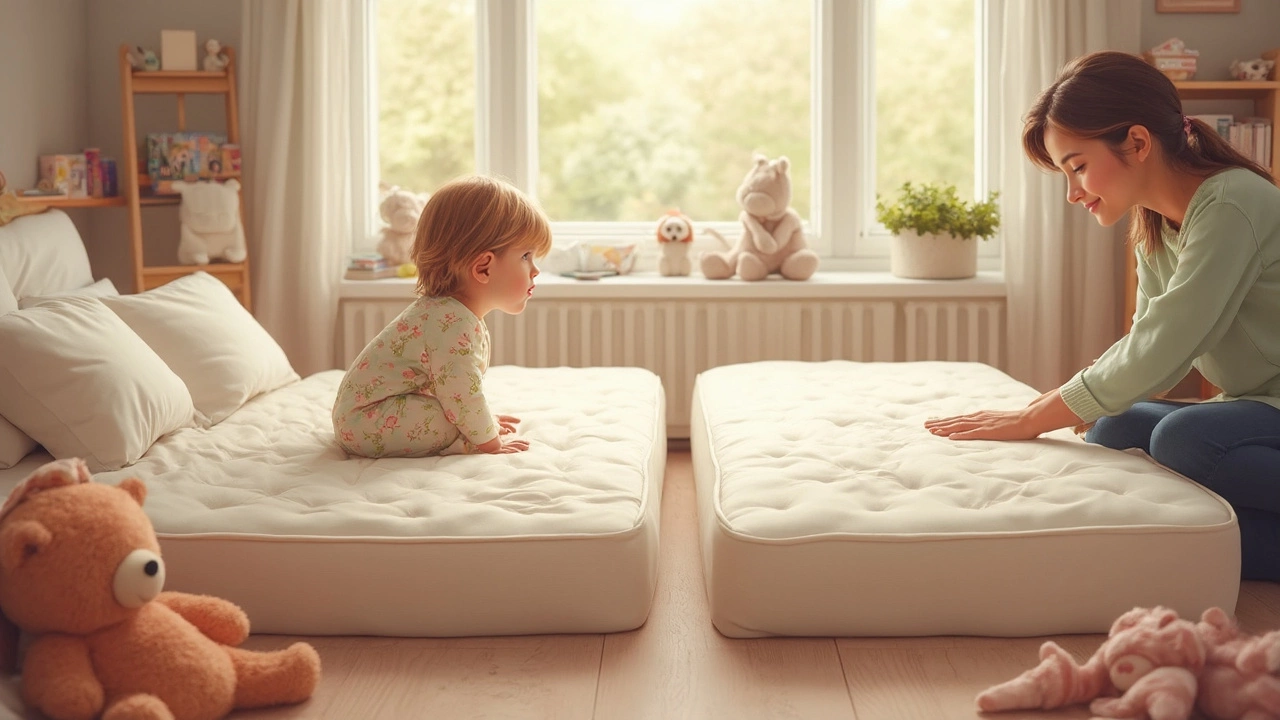Is Memory Foam Ok for Toddlers? What Every Parent Should Know

Some parents swear by memory foam for their tired backs. But when it comes to toddlers, things aren’t quite as simple. If you’re shopping for your kid’s first bed, you might wonder if memory foam is actually safe or if it’s just clever marketing.
Here’s the deal: toddlers have different sleep needs than adults. Their bones and bodies are still growing fast. That means the mattress you pick can make a real difference—not just for their comfort, but for their health. Memory foam feels soft and cozy, but softness isn’t always best for little ones. It’s easy to assume that a plush surface is good, but too much sink can actually mess with their alignment or make it harder for them to move around safely.
- What Is Memory Foam, Anyway?
- How Does Memory Foam Impact Toddler Safety?
- The Pros and Cons for Little Sleepers
- Smart Tips for Choosing Your Toddler’s Bed
What Is Memory Foam, Anyway?
Memory foam is everywhere these days, but what is it really? Basically, it’s a type of polyurethane foam that was first developed by NASA in the 1960s to make airplane seats safer and more comfortable. Now, you mostly see it in mattresses, pillows, and even some shoes. The reason folks love it? It molds to your body shape when you lay down and slowly bounces back once you get up.
When it comes to memory foam in toddler beds, it’s important to know how it works. The foam reacts to heat and pressure, so when you put a toddler on it, their body weight and warmth make the mattress contour around them. Sounds comfy, right? It can be, but there’s more to think about. The denser and thicker the foam, the deeper your kid will sink in—which isn’t always great for young bodies still learning to move in their sleep.
Here’s a quick look at memory foam facts that matter for parents:
| Feature | What it means for toddlers |
|---|---|
| Body-contouring | May restrict movement or make turning harder |
| Heat retention | Can get warm, especially if bedroom is already hot |
| Softness | Too-soft surfaces may increase suffocation risk for kids under 3 |
| Chemicals (VOCs) | Some brands have ‘new mattress smell’ from off-gassing |
Another thing: there are different types of memory foam—traditional, gel-infused (which feels cooler), and “plant-based” (which claims to use fewer chemicals). Not all are made equal. Some mattresses pass safety standards for kids, but others cut corners. Always check if it’s certified by a group like CertiPUR-US, which tests for toxic ingredients.
So, memory foam isn’t mysterious, but finding the right one for your toddler takes a bit of homework. Stick around to figure out if it’s really the best choice for your kid’s sleep and safety.
How Does Memory Foam Impact Toddler Safety?
Memory foam is famous for its “sinking in” feel, which hugs your body shape. For grown-ups, that’s relaxing. But for toddlers, there’s real concern. Their bodies aren’t strong enough to always push themselves up if they get stuck in a dip, especially when they’re sleepy or half-awake at night. This sinking feeling can actually make it harder for them to roll over or reposition if needed.
Doctors and sleep experts warn that a surface that’s too soft can increase the chance of suffocation, especially for kids under 2. That’s one of the main reasons why firm mattresses are recommended for the little ones. A 2021 study out of Australia found that infants and toddlers sleeping on softer mattresses, including some memory foam options, had a higher risk of blocked breathing if they rolled face-down.
Besides just softness, memory foam also traps heat more than traditional mattresses. Kids naturally run warmer and tend to sweat a lot at night, so a mattress that keeps in heat can lead to overheating. And overheating is linked to a bump in night-wakings and even greater sleep risks. Check this quick comparison:
| Factor | Memory Foam | Traditional (Spring/Firm Foam) |
|---|---|---|
| Breathability | Low to medium | High |
| Firmness | Usually soft-medium | Firm |
| Heat Retention | High | Low |
| Roll-over Ease | Harder | Easier |
It’s not all bad, though. Most memory foam mattresses today are made “certified” by CertiPUR-US, which means they’re free from some of the big-name toxic chemicals. That’s a sign the foam won’t let off anything that could mess with your toddler’s breathing or skin. Still, you have to check the specs, since cheap knock-offs can still contain sketchy stuff.
Bottom line? Safety guides say toddlers older than 2 may be okay with a slightly softer surface, but anything super plush or heat-trapping should be skipped. When in doubt, look for mattresses made specifically for kids, not adult beds cut down to size.

The Pros and Cons for Little Sleepers
Let’s get into what’s great and what’s not so great when it comes to memory foam and toddlers. It’s easy to get dazzled by the hype, but the reality is, not every "super comfy" mattress suits tiny kids. Here’s how things stack up for your toddler beds search:
- Pro: Pressure relief and comfort. Memory foam gives way and cushions pressure points, so it can feel gentle on growing bodies. No annoying springs poking through.
- Pro: Hypoallergenic properties. Many memory foam mattresses block dust mites and common allergens, which is handy for little ones with sensitive noses.
- Con: Not always firm enough. Here’s the catch—memory foam is cozy for adults but often too soft for toddlers. Pediatricians and safety standards recommend a firmer sleep surface for children under 3, since it reduces the risk of sinking in and is safer for little spines.
- Con: Off-gassing and chemicals. Many memory foam options have that chemical "new mattress" smell. That’s because they release volatile organic compounds (VOCs), which can irritate your child’s respiratory system. Some brands now offer "CertiPUR-US" certification, but you still want to air the mattress out for a few days.
- Con: Heat retention. Memory foam tends to trap heat. This means kids may get sweaty or uncomfortable during warm nights, which doesn’t help with getting a full night’s rest.
- Pro/Con: Durability. Memory foam generally lasts longer than spring mattresses, but some kids might jump on the bed (let’s be real) and create permanent dents or sags.
To lay it all out clearly, check out this quick comparison of memory foam versus a typical innerspring mattress for toddlers:
| Feature | Memory Foam | Innerspring |
|---|---|---|
| Firmness | Usually medium-soft | Usually firm |
| Allergy-friendly | Yes, often hypoallergenic | No, can collect dust mites |
| Breathability | Traps heat | Better airflow |
| Safety for Toddlers | Can be too soft | Generally meets safety firmness |
| Durability | High, but can sag | Good, may squeak or sag over time |
Pediatric sleep experts recommend choosing a mattress with a firmness rating of at least a 7 out of 10 for kids under 4. If the memory foam you’re eyeing feels like a marshmallow, it’s too soft. And don’t forget to always check the manufacturer’s age guidelines—most memory foam beds are marked for ages 3 and up for a reason.
Smart Tips for Choosing Your Toddler’s Bed
You’re ready to move your little one from a crib to a big kid bed, but staring at all the options can feel overwhelming. Here’s what you really need to look for, especially if you’re wondering about memory foam:
- Firmness is key. Toddlers need a firmer mattress than adults. The American Academy of Pediatrics says a firm, flat surface is safest for young children—too much sink or squish can put them at risk, whether it’s for SIDS under age one, or just making it harder for toddlers to get up or roll over.
- Look at the materials. If you pick memory foam, make sure it's CertiPUR-US certified. That means it’s been tested for harmful chemicals and won’t off-gas VOCs (those sketchy chemical smells). Low-quality foams can release stuff you don’t want your kid breathing in while they sleep.
- Check the height. A mattress that’s too tall can make it easier for kids to fall off or struggle when climbing in and out. Most toddler beds work best with a mattress thickness of 4-6 inches.
- Cover matters, too. Waterproof or washable covers make cleanup after accidents or spills so much easier. Look for something soft but tough—some covers can be wiped instead of fully washed.
- Watch the warranty. Some toddler mattresses only last a year or two before they break down, but the better ones give you a three- to five-year warranty. If memory foam starts sagging, it’s time to swap it out.
Here’s a quick rundown to help you spot what works and what doesn’t when picking out toddler beds:
| Feature | Best Practice | Why It Matters |
|---|---|---|
| Firmness | Medium-firm to firm | Supports spine and helps toddlers move safely |
| Height | 4-6 inches | Reduces fall risk; easy for toddlers to climb |
| Certifications | CertiPUR-US, Greenguard | Limits chemical exposure |
| Cover | Removable, waterproof | Easy cleaning and allergy reduction |
| Warranty | At least 3 years | Guarantees mattress quality and safety |
One last tip: if your child has allergies or asthma, check for hypoallergenic materials. Lots of new mattresses use plant-based foams or organic cotton, which can help keep sniffles (and drama) to a minimum at night.


